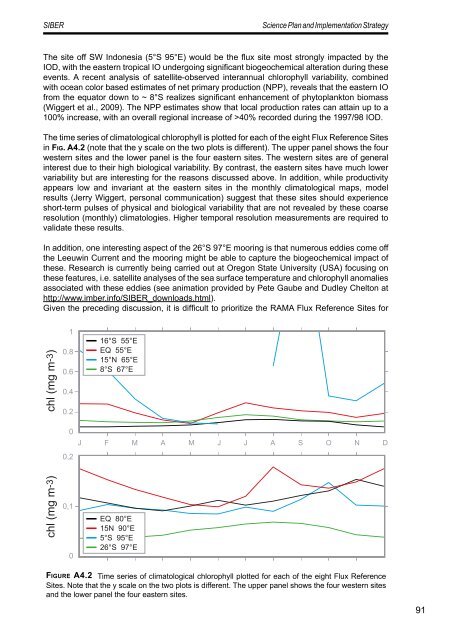SIBER SPIS sept 2011.pdf - IMBER
SIBER SPIS sept 2011.pdf - IMBER
SIBER SPIS sept 2011.pdf - IMBER
Create successful ePaper yourself
Turn your PDF publications into a flip-book with our unique Google optimized e-Paper software.
<strong>SIBER</strong><br />
Science Plan and Implementation Strategy<br />
The site off SW Indonesia (5°S 95°E) would be the flux site most strongly impacted by the<br />
IOD, with the eastern tropical IO undergoing significant biogeochemical alteration during these<br />
events. A recent analysis of satellite-observed interannual chlorophyll variability, combined<br />
with ocean color based estimates of net primary production (NPP), reveals that the eastern IO<br />
from the equator down to ~ 8°S realizes significant enhancement of phytoplankton biomass<br />
(Wiggert et al., 2009). The NPP estimates show that local production rates can attain up to a<br />
100% increase, with an overall regional increase of >40% recorded during the 1997/98 IOD.<br />
The time series of climatological chlorophyll is plotted for each of the eight Flux Reference Sites<br />
in Fig. A4.2 (note that the y scale on the two plots is different). The upper panel shows the four<br />
western sites and the lower panel is the four eastern sites. The western sites are of general<br />
interest due to their high biological variability. By contrast, the eastern sites have much lower<br />
variability but are interesting for the reasons discussed above. In addition, while productivity<br />
appears low and invariant at the eastern sites in the monthly climatological maps, model<br />
results (Jerry Wiggert, personal communication) suggest that these sites should experience<br />
short-term pulses of physical and biological variability that are not revealed by these coarse<br />
resolution (monthly) climatologies. Higher temporal resolution measurements are required to<br />
validate these results.<br />
In addition, one interesting aspect of the 26°S 97°E mooring is that numerous eddies come off<br />
the Leeuwin Current and the mooring might be able to capture the biogeochemical impact of<br />
these. Research is currently being carried out at Oregon State University (USA) focusing on<br />
these features, i.e. satellite analyses of the sea surface temperature and chlorophyll anomalies<br />
associated with these eddies (see animation provided by Pete Gaube and Dudley Chelton at<br />
http://www.imber.info/<strong>SIBER</strong>_downloads.html).<br />
Given the preceding discussion, it is difficult to prioritize the RAMA Flux Reference Sites for<br />
chl (mg m-3)<br />
1<br />
0.8<br />
0.6<br />
0.4<br />
0.2<br />
0<br />
0,2<br />
16°S 55°E<br />
EQ 55°E<br />
15°N 65°E<br />
8°S 67°E<br />
J F M A M J J A S O N D<br />
chl (mg m-3)<br />
0,1<br />
0<br />
EQ 80°E<br />
15N 90°E<br />
5°S 95°E<br />
26°S 97°E<br />
Fi g u r e A4.2 Time series of climatological chlorophyll plotted for each of the eight Flux Reference<br />
Sites. Note that the y scale on the two plots is different. The upper panel shows the four western sites<br />
and the lower panel the four eastern sites.<br />
91












